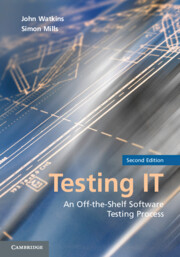Book contents
- Frontmatter
- Contents
- Foreword to the Second Edition by Geoff Thompson
- Foreword to the First Edition by Maurice Rosenburgh
- Acknowledgments
- 1 Introduction
- PART 1 THE TRADITIONAL TESTING PROCESS
- PART 2 THE TESTING PROCESS IN THE REAL WORLD: ILLUSTRATIVE CASE STUDIES
- PART 3 THE APPENDICES
- Appendix A Terms of Reference for Testing Staff
- Appendix B Testing Guides
- Appendix C Test Plan Document Template
- Appendix D Test Specification Document Template
- Appendix E Test Script Template
- Appendix F Test Result Record Form Template
- Appendix G Test Log Template
- Appendix H Test Certificate Template
- Appendix I Reuse Pack Checklist
- Appendix J Test Summary Report Template
- Appendix K Equivalence Partition Example
- Appendix L Boundary Value Analysis Example
- Appendix M State Transition Example
- Appendix N Pairwise Testing Example
- Appendix O Automated Testing Tool Selection Criteria
- Appendix P Usability Testing Overview
- Appendix Q Testing Process Health Check
- Appendix R The Testing of Object-Oriented Software
- Appendix S Pragmatic Test Process Adoption – a Real-World Example
- References
- Glossary
- Index
Appendix R - The Testing of Object-Oriented Software
Published online by Cambridge University Press: 03 May 2011
- Frontmatter
- Contents
- Foreword to the Second Edition by Geoff Thompson
- Foreword to the First Edition by Maurice Rosenburgh
- Acknowledgments
- 1 Introduction
- PART 1 THE TRADITIONAL TESTING PROCESS
- PART 2 THE TESTING PROCESS IN THE REAL WORLD: ILLUSTRATIVE CASE STUDIES
- PART 3 THE APPENDICES
- Appendix A Terms of Reference for Testing Staff
- Appendix B Testing Guides
- Appendix C Test Plan Document Template
- Appendix D Test Specification Document Template
- Appendix E Test Script Template
- Appendix F Test Result Record Form Template
- Appendix G Test Log Template
- Appendix H Test Certificate Template
- Appendix I Reuse Pack Checklist
- Appendix J Test Summary Report Template
- Appendix K Equivalence Partition Example
- Appendix L Boundary Value Analysis Example
- Appendix M State Transition Example
- Appendix N Pairwise Testing Example
- Appendix O Automated Testing Tool Selection Criteria
- Appendix P Usability Testing Overview
- Appendix Q Testing Process Health Check
- Appendix R The Testing of Object-Oriented Software
- Appendix S Pragmatic Test Process Adoption – a Real-World Example
- References
- Glossary
- Index
Summary
Introduction
Irrespective of the technology employed in the development of a software system, any testing process will involve a number of common activities that must be performed by staff with appropriate skills and completed in a particular order to ensure successful testing – this is the essence of a repeatable, predictable, reusable process.
Where an organization has a requirement to test a number of different applications, each of which may have been developed using different tools, techniques, and languages, rather than emphasizing the differences between the applications and their implementation technologies, it is much more beneficial to look for the similarities.
Where differences that impact on the testing process are observed, these exceptions should be documented, and the testing solutions that are adopted to address them incorporated into the process as supplementary activities for future use.
Thus the starting point for determining how to approach the testing of any new or novel technology should be to assume that the testing will fit into the currently used process, and not throw current best practice away in favor of creating a new process from first principles.
This appendix discusses the particular issues involved in testing object-oriented (OO) software systems (36) and makes a number of proposals for how to approach this activity. Specifically, Section R2 briefly reviews the process of object-oriented software development, Section R3 discusses the impact of OO on the management and planning of testing, and Section R4 examines the impact of OO on the design of tests.
- Type
- Chapter
- Information
- Testing ITAn Off-the-Shelf Software Testing Process, pp. 298 - 304Publisher: Cambridge University PressPrint publication year: 2010

